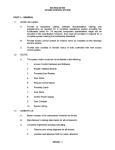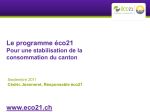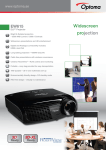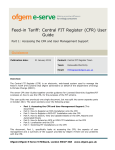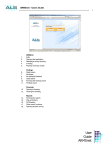Download ECO2 Technical Requirements Consultation
Transcript
ECO2 Technical Requirements Consultation Consultation Publication date: Response deadline: 30 October 2015 30 November 2015 by 9am Contact: Claire Valente Team: Energy Efficiency and Social Programmes Email: [email protected] Overview: This consultation relates to two areas of scheme delivery within ECO2: lifetimes for wall insulation measures without an appropriate guarantee and technical monitoring re-inspection requirements. We welcome your views on these proposals. This consultation closes at 9am on 30 November 2015. Ofgem E-Serve 9 Millbank, London SW1P 3GE www.ofgem.gov.uk ECO2 Technical Requirements Consultation 1. Introduction The Energy Company Obligation (ECO) is a government scheme which requires larger energy companies to deliver energy efficiency measures to domestic premises in Great Britain. This consultation relates to ECO21, which is the second obligation period under the scheme. It runs from 1 April 2015 to 31 March 2017 and is the successor of ECO12, which ran from 1 January 2013 to 31 March 2015. Through this consultation, we are seeking views from stakeholders on our proposals relating to two technical aspects of scheme delivery under ECO2. We have developed these proposals to support energy companies to achieve better outcomes for consumers and more cost effective scheme delivery. 1) Lifetimes for wall insulation measures without an appropriate guarantee Measures installed under ECO have an expected ‘standard’ lifetime which is used to calculate the cost or carbon savings that will be achieved by the measure. Wall insulation measures, such as cavity wall insulation, are expected to deliver savings for up to 42 years. In order to provide assurance that standard lifetime savings will be achieved for these measure types, they should be accompanied by an appropriate 25 year guarantee. This consultation sets out our proposed approach for wall insulation measures which are delivered without an appropriate guarantee. We propose that the default lifetime for these measures is 0 years, unless alternative assurance of the measure lifetime is available. 2) Technical monitoring re-inspections Technical monitoring verifies whether a measure has been installed to the relevant installation standards by a person of appropriate qualification and expertise, and whether it complies with the relevant eligibility criteria. Independent monitoring agents visit dwellings during and/or after the installation of ECO measures in order to ensure that works have been carried out to the expected standard. Where measures fail these inspections, the energy company is required to undertake remedial works which can be re-inspected on site by the original suitably qualified technical monitoring agent. We propose that some technical monitoring re-inspections may be undertaken remotely following completion of remedial work, where certain requirements are met. 1 The Gas and Electricity (Energy Company Obligation) Order 2014 is available at: http://www.legislation.gov.uk/uksi/2014/3219/pdfs/uksi_20143219_en.pdf 2 The Electricity and Gas (Energy Companies Obligation) (Amendment) (No. 2) Order 2014 http://www.legislation.gov.uk/uksi/2014/3231/pdfs/uksi_20143231_en.pdf 2 ECO2 Technical Requirements Consultation Next steps The consultation will be open from 30 October to 9am on 30 November 2015. Responses should be directed to [email protected] or: Claire Valente Energy Efficiency and Social Programmes Ofgem, 9 Millbank, London, SW1P 3GE We plan to publish our decision, including a summary of responses in January 2016. Unless marked confidential, all responses will be published on our website. 3 ECO2 Technical Requirements Consultation 2. Lifetime for wall insulation measures without an appropriate guarantee In this section we set out our proposed approach to determining the lifetime for wall insulation measures installed in ECO2 without an appropriate guarantee3. Background The standard lifetimes4 for ECO wall insulation measures are awarded in cases where measures are supported by an appropriate guarantee (see table 1 below). Table 1 Standard lifetime for wall insulation measures Measure External wall insulation Internal wall insulation Cavity wall insulation Park home insulation Party cavity wall insulation Standard lifetime (years) 36 36 42 30 42 If an appropriate guarantee is not provided, we must determine the lifetime to be awarded. Our approach under ECO1 The approach we took under ECO1 to determine the appropriate lifetime for each measure without an appropriate guarantee is available on our website5. We identified four scenarios when a guarantee may not be available (see table 2 below). We consider that these scenarios also apply under ECO2. 3 The criteria for an appropriate guarantee are set out in chapter 8 of the ECO Guidance: Delivery (pages 54-55) : https://www.ofgem.gov.uk/publications-and-updates/energy-company-obligation-2015-17-eco2-guidance-delivery 4 All standard lifetimes are available in the ECO Measures Table: https://www.ofgem.gov.uk/sites/default/files/docs/2015/10/eco2_measures_table_-_oct_2015-_v2_3_-_final.pdf 5 https://www.ofgem.gov.uk/publications-and-updates/eco1-lifetime-wall-insulation-measures-without-appropriateguarantee 4 ECO2 Technical Requirements Consultation Table 2 Scenarios where a wall insulation measure is not supported by a guarantee Scenario 1 Not eligible ECO measure Details The installer is not PAS 2030-certified There is no evidence the measure has been installed in accordance with building regulations Other core ECO eligibility criteria are not met 2 Limited The installer conceals lack of guarantee assurance that from energy company standard Guarantee was applied for but not issued lifetime due to concerns about quality and/or savings will be suitability of the installation achieved Guarantee was applied for but not issued as no system certificate was valid for the measure and no equivalent assurance provided Guarantee not issued as applied for retrospectively 3 Some Proactive discussions pre-installation to assurance that find alternative route to supporting standard lifetime lifetime Guarantee quality assurance rules were savings will be followed but guarantee was not issued achieved and installer now ceased to trade 4 No guarantee It is not possible to obtain a guarantee for available this measure type as no appropriate guarantee is available [Note: we are not currently aware of any wall insulation measure types where a guarantee is not available] ECO1 approach This is not an eligible ECO measure. To be rejected through our standard rejections process. We have limited assurance regarding the quality of installation of the measure. These measures will receive the default lifetime of 2 years. [Note: this was the approach under ECO1. We are consulting on a change for ECO2.]. There is some assurance regarding the quality of installation of the measure. There may be sufficient assurance for these measures to have up to the applicable standard lifetime. Measures will be assessed on a case-by-case basis Ofgem to engage guarantee companies to anticipate such cases in advance. If presented, identify whether this is something that could receive a guarantee either in this instance or in future. If not, consider whether additional assurance is available for this measure type. Award up to the applicable standard lifetime for the measure, subject to no other concerns. In determining this lifetime under ECO1, we considered measures on a case-by-case basis, taking into account the reasons why a guarantee was not in place and any alternative assurance that the standard lifetime savings could be achieved. Measures delivered without an appropriate guarantee were awarded a default lifetime of 2 years (see scenario 2), unless alternative assurance was available (see scenarios 3 and 4). This lifetime took account of three key factors; greater risk of measure failure, risk of replacement and double-counting under future schemes, and the length of the scheme. 5 ECO2 Technical Requirements Consultation ECO2 is scheduled to run from April 2015 to March 2017. This gave us assurance that a wall insulation measure installed under ECO1 could be remediated by the energy company that delivered it, if it failed within this two-year period. This supported our default lifetime of 2 years under scenario 2 for measures delivered in ECO1. ECO2 proposal Wall insulation measures which are delivered in accordance with the ECO guidance will be accompanied by an appropriate guarantee. The proposals set out below relate to wall insulation measures which are installed without an appropriate guarantee. We expect these will be limited to a very small proportion of ECO2 wall insulation measures. These measures may be identified retrospectively through energy company compliance checks and/or Ofgem audits. We understand that the scenarios that were identified under ECO1 will remain. However, we believe it is appropriate to reconsider our treatment of them under ECO2. We have developed our proposals below with a view to help protect consumers from receiving poor quality installations and to help ensure that, where alternative assurance can be provided, there will be safeguards in place to help address future issues. Scenario 1 Wall insulation measures in scenario 1 do not meet core ECO eligibility criteria and so are not eligible ECO2 measures. Scenario 2 Measures in scenario 2 are eligible ECO measures. However, there is insufficient evidence that these measures have been installed in accordance with a suitable quality assurance framework, which suggests that they are at higher risk of failure within the standard measure lifetime, relative to other wall insulation measures. We also consider that they would have inadequate protection for the consumer. We propose to set a default lifetime of 0 years for wall insulation measures delivered under ECO2 without an appropriate guarantee or alternative assurance (see scenario 2). Measures which are awarded a lifetime of 0 years will receive no ECO savings. Where these measures fail, this lifetime would allow potential for them to be replaced under future schemes. This default lifetime of 0 years would further reinforce the need for an appropriate guarantee , offering greater consumer protection, supporting high quality and standards of installation, and ensuring that the carbon saving objectives of the scheme are not eroded. 6 ECO2 Technical Requirements Consultation Scenario 3 Where alternative assurance is available for wall insulation measures, rather than an appropriate guarantee, we propose to determine the measure lifetime through a case-by-case assessment of the evidence available. The lifetime awarded could range from 0 up to the applicable standard lifetime for the measure type. Scenario 4 Where no guarantee is available within industry for a particular type of wall insulation measure, we propose to determine the measure lifetime through a case-by-case assessment of the evidence available. This lifetime could range from 0 up to the applicable standard lifetime for the measure type. Case-by-case assessments (under scenario 3 &4) Where a case-by-case assessment is required, we will engage with energy companies to gather the information required and work towards a swift conclusion. The process will reference our criteria for the assessment of a non-standard lifetime, included here in Appendix 3. Implementation The outcome of the consultation will apply to all wall insulation measures which are notified during ECO2 without an appropriate guarantee. Questions for Consultation Question 1 1.1 Do you agree that the default lifetime for wall insulation measures without an appropriate guarantee is 0 years? 1.2 Please give reasons for your answer. Question 2 2.1 Where there is alternative assurance available in support of the lifetime, do you agree that we should determine the lifetime through a case-by-case assessment of the evidence, up to a maximum of the standard lifetime for that measure type? 2.2 Please give reasons for your answer. 7 ECO2 Technical Requirements Consultation Question 3 3.1 Do you consider that an alternative approach would be more appropriate in determining the lifetime for wall insulation measures without an appropriate guarantee? 3.2 If yes, please provide details. 8 ECO2 Technical Requirements Consultation 3. Technical Monitoring Re-inspections In this section we propose that, subject to certain requirements, ECO technical monitoring reinspections may be undertaken remotely following the completion of remedial works. These proposals do not relate to score monitoring. Background Each quarter, at least 5% of the measures installed in ECO must be monitored to confirm that our technical requirements have been met and to confirm that the score is correct. Where an ECO measure fails technical monitoring, the energy company must conduct remedial work on that measure if it is to be eligible under ECO2. This remedial work must also pass a reinspection to verify that any failures identified through technical monitoring have been resolved. Proposal We propose that monitoring agents may be able to conduct re-inspections remotely via a deskbased process, subject to certain requirements. Remote re-inspections could result in a reduction to the cost of delivering ECO measures and a better customer experience. However, it is necessary to ensure that: a) remote re-inspections will provide the same levels of assurance as site visits that the necessary remedial work has been completed; and b) adequate protections are in place for those consumers who have suffered from poor installations. We are seeking the views of our stakeholders on whether remote re-inspections are appropriate, and on our proposed requirements for safeguarding consumers and providing assurance that necessary remedial works are undertaken. We believe that there are some types of technical monitoring failure for which remedial work can only be properly re-inspected through a site visit, and some for which a remote reinspection may be appropriate. Appendix 1 contains our proposals as to which types of failure could be re-inspected remotely. Where the final column is ‘yes’ we propose that remote reinspections may be possible depending on the exact nature of the fail and subject to the safeguards set out below. Note that these proposals relate only to technical monitoring. Existing processes to resolve score monitoring failures will not be affected6. 6 Our Explanatory notes for monitoring detail the process should a score monitoring question fail. https://www.ofgem.gov.uk/publications-and-updates/energy-company-obligation-monitoring 9 ECO2 Technical Requirements Consultation Protocols and Safeguards In order to ensure that remote re-inspections give us assurance that remedial works have been undertaken to the required standard, suitable protocols and safeguards would be put in place. We propose that: 1. Prior to remedial work taking place, the technical monitoring agent should determine if a fail can be re-inspected remotely. The 18 questions marked as yes in Appendix 1 would only be suitable for remote re-inspection subject to the discretion of the technical monitoring agent. 2. During the original monitoring inspection, the technical monitoring agent should take a photograph of the aspect of the installation that failed monitoring. The installer conducting the remedial work should take a photograph showing the same view which clearly indicates that the fail has been remedied. 3. The photographs taken by the technical monitoring agent and installer should record the date on which the photo was taken, location of the property and the measure being assessed, for example, a timestamped photo with an associated GPS location. 4. In addition to photographic evidence, the technical monitoring agent may request additional evidence. 5. The remote re-inspections should be conducted by the same technical monitoring agent who conducted the original monitoring inspection. 6. If the documentary evidence provided does not provide sufficient certainty for the technical monitoring agent to determine that the necessary remedial work has or has not been completed to the required standard, the technical monitoring agent must undertake a site visit. 7. Monitoring agents must ensure that on-site inspections are conducted for a proportion of work that was re-inspected remotely. Implementation 8. We will publish the outcome of this consultation in January 2016. Our existing rules for technical monitoring re-inspections will continue to apply to all measures which undergo technical monitoring re-inspections during this consultation period. The proposals set out here, if introduced, will apply to measures that are re-inspected following publication of the outcome of this consultation, subject to all required protocols and safeguards being met. 10 ECO2 Technical Requirements Consultation 9. It is not envisaged that any outcome of this consultation will require mandatory remote re-inspections; suppliers will be able to continue to conduct all re-inspections on-site. Questions for Consultation Question 4 4.1. Do you agree that in some circumstances, remote re-inspections are appropriate? 4.2 Please give reasons for your answer. Question 5 5.1 Do you agree that it may be possible to remotely re-inspect the technical monitoring failure types we suggest in Appendix 1? 5.2 Please give reasons for your answer. 5.3 Please identify those questions in Appendix 1 where you disagree with the proposal. 5.4 Please identify any other questions where you consider the proposal would be appropriate. Question 6 6.1 Do you agree that technical monitoring fails can only be re-inspected remotely in cases where the technical monitoring agent has deemed it possible during their original inspection? 6.2 Do you agree that remote re-inspections must be conducted using photographs taken before and after remedial works, and that original photographs must be taken by the monitoring agent during their original inspection? 6.3 Do you agree that the photographs need to be GPS location-stamped? 6.4 Do you agree that the technical monitoring agent should be able to request additional evidence to assist with the remote re-inspection? If so, please provide examples of suitable evidence. 6.5 Do you agree that the remote re-inspection should be conducted by the same agent who conducted the original site audit? 6.6 Do you agree that the technical monitoring agent must conduct a site audit if there is any doubt in the evidence assessed during the remote re-inspection? 11 ECO2 Technical Requirements Consultation 6.7 Do you think that monitoring agents should monitor a minimum percentage of reinspections on site? If so, what is an appropriate percentage? 6.8 Please provide any further suggestions for processes that may increase the accuracy of remote re-inspections, or enhance consumer protections. Question 7 7.1. Please estimate the time that could be saved by these proposals? 12 ECO2 Technical Requirements Consultation Appendix 1 – Technical monitoring questions for remote re-inspection Technical Monitoring Questions Ref Measure Type Inspection Stage Question Suitable for remote reinspection? Yes BR.1 Boiler Repair Post-Installation Where a boiler and hot water storage vessel have been repaired or replaced, have any associated replacement pipes or pipes that have been exposed as part of the works or are now otherwise accessible been insulated where possible? BR.2 Boiler Repair Post-Installation Does the boiler produce hot water for the central heating system? No BR.3 Boiler Repair Post-Installation If the boiler is designed to produce domestic hot water, is the boiler producing domestic hot water? No Post-Installation Where a boiler and hot water storage vessel have been repaired or replaced, have any associated replacement pipes or pipes that have been exposed as part of the works or are now otherwise accessible been insulated where possible? Yes Yes No NB.1 New Boiler NB.2 New Boiler Post-Installation If holes or openings have been made through the fabric of the premises due to the installation of a new boiler, have they been made good? (including condensate pipe, pressure relief valve, gas flue terminals) NB.3 New Boiler Post-Installation Does the boiler produce hot water for the central heating system? 13 ECO2 Technical Requirements Consultation NB.4 CWI.1 CWI.2 CWI.3 CWI.4 CWI.5 DP.1 DP.2 ESHR.1 ESHR.2 ESHR.3 ESHR.4 NESH.1 NESH.2 NESH.3 NESH.4 New Boiler Cavity Wall Insulation Cavity Wall Insulation Cavity Wall Insulation Cavity Wall Insulation Cavity Wall Insulation Draught Proofing Draught Proofing Electric Storage Heater Repair Electric Storage Heater Repair Electric Storage Heater Repair Electric Storage Heater Repair New Electric Storage Heater New Electric Storage Heater New Electric Storage Heater New Electric Storage Heater Post-Installation Post-Installation Post-Installation Post-Installation Post-Installation If the boiler is designed to produce domestic hot water, is the boiler producing domestic hot water? Is the insulation material suitable for use with the property’s exposure level to wind driven rain? Does the form of the construction of the property suggest that it was suitable for the material that has been installed? Does the current condition of the property suggest that it was suitable for the material that has been installed? Does the drilling pattern conform to the appropriate materials compliance certificate? No No No No Yes Post-Installation Have all injection holes been filled? Yes Post-installation Has the draught proofing been securely fixed to all doors and windows? No Post-installation Are all newly treated windows and doors fully operational? No Post-installation Is the repair to an Electric Storage Heater as opposed to a panel heater or other kind of heater? No Post-installation Does the Electric Storage Heater activate and produce heat? No Post-installation Post-installation Post-installation Post-installation Post-installation Post-installation 14 Is the property on an Economy 7 or differential off-peak tariff? Where the property is on a differential off-peak tariff, are the Elecitric Storage Heaters connected to a separate consumer unit? Is the installation an Electric Storage Heater as opposed to a panel heater or other kind of heater? Does the Electric Storage Heater activate and produce heat? Are all storage heaters fitted with an automatic charge control? Is the fan on fan-assisted storage heater(s) controlled by a thermostat? No No No No No No ECO2 Technical Requirements Consultation NESH.5 New Electric Storage Heater Post-installation NESH.6 New Electric Storage Heater Post-Installation EWI.1 External Wall Insulation Competency (mid-installation only) EWI.2 External Wall Insulation Competency (mid-installation only) EWI.3 External Wall Insulation Competency (mid-installation only) EWI.4 External Wall Insulation Competency (mid-installation only) EWI.5 EWI.6 EWI.7 EWI.8 EWI.9 EWI.10 EWI.11 External Wall Insulation External Wall Insulation External Wall Insulation External Wall Insulation External Wall Insulation External Wall Insulation External Wall Insulation Mid-Installation Mid-Installation Mid-Installation Mid-Installation Mid-Installation Mid-Installation Mid-Installation 15 Is the property on an Economy 7 or differential off-peak tariff? Where the property is on a differential off-peak tariff, are the Electric Storage Heaters connected to a separate consumer unit? Is there at least one carded operative that meets the competence requirements for the relevant tasks as specified in B4-l4 of Table B4 of PAS:2030:2014 Has the pre-installation survey been completed fully in accordance to PAS2030:2014? Is the measure/system being installed as specified in the appropriate product certificate and/or system designer's instructions? Where telecommunications are affected by the EWI installation, has the relevant telecoms provider been contacted? Are insulation boards tightly butted together in a break bond pattern? Are insulation boards cut at right angles to allow tight butting? Are only full or half insulation boards fitted in an interlocking pattern? Are all insulation boards undamaged? Have cavities within cavity walls been filled or closed off to prevent an air path behind the insulation board? Have gaps been sealed to prevent an air path between the insulation board and wall? Are the insulation boards appropriately bonded and/or anchored as specified in the system designers instructions? No No No No No No No No No No No No No ECO2 Technical Requirements Consultation EWI.12 EWI.13 EWI.14 EWI.15 EWI.16 EWI.17 External Wall Insulation External Wall Insulation External Wall Insulation External Wall Insulation External Wall Insulation External Wall Insulation Mid-Installation Post-Installation No Post-Installation Has the render/cladding been fully applied? No Post-Installation Have window and door reveals been insulated? No Post-Installation Competency (mid-installation only) FRI.2 Flat Roof Insulation Mid-Installation FRI.3 Flat Roof Insulation Mid-Installation FRI.4 Flat Roof Insulation Mid-Installation FRI.6 Flat Roof Insulation Post-installation WG.1 No Are there any visible signs of water penetration? Flat Roof Insulation Flat Roof Insulation Window Glazing No Post-Installation FRI.1 FRI.5 Is the EWI installation being carried out appropriately without compromising the accessibility, functionality and/or safety of the existing services? ( for example gas, electric, water, telephone, etc.) Where services have penetrated the insulation board have these been sealed appropriately? Have all exterior facing wall areas (above DPC) been insulated to reduce the effects of thermal bridging? Is the measure/system being installed as specified in the appropriate product certificate and/or system designer's instructions? Are boards butted together with no gaps at abutments? Has a 300mm insulation ‘Up stand’ been installed from the bottom surface of the horizontal layer around the perimeter of the roof on the internal façade of any parapet or penetrating service riser? Have existing cavity trays been raised and/or new ones provided at abutment of roof and wall? Has a waterproof membrane been applied over the whole of the insulated area, including ‘Up Stands’ after the laying of the insulation board? No No No No No No Post-installation Is there any evidence of water penetration? No Post-Installation Have all windows and doors in the premises that haven’t been treated before now been treated? Yes 16 ECO2 Technical Requirements Consultation HC.1 HC.2 Heating Controls Heating Controls Post-Installation Post-Installation IWI.1 Internal Wall Insulation Competency (mid-installation only) IWI.2 Internal Wall Insulation Competency (mid-installation only) IWI.3 IWI.4 IWI.5 Internal Wall Insulation Internal Wall Insulation Internal Wall Insulation Mid-Installation Mid-Installation Mid-Installation Are the heating controls linked to a functioning heating system? Do the heating controls turn on the domestic heating system? Is there at least one carded operative that meets the competence requirements as specified in B8.l4 of table B8 of PAS2030:2014 Is the measure/system being installed as specified in the appropriate product certificate and/or system designer’s instructions? Have all gaps behind the new insulation been sealed to prevent the circulation of cold air if applicable? Has the insulation been continued into the inter floor void? Where services have penetrated the vapour control layer have these been sealed appropriately? If the floor is suspended timber, is the insulated dry lining bedded on a strip of pre-compressed expanding foam nailed to the floor? Is the insulation sealed around all adjoining boards, walls, ceilings and floors? No No No No No No No IWI.6 Internal Wall Insulation Mid-Installation IWI.7 Internal Wall Insulation Post-installation IWI.8 Internal Wall Insulation Post-installation Is the insulation continued 400mm along all party and solid partition walls? No Post-Installation Is the thickness of insulation consistent throughout the loft area? No Post-Installation Has insulation been close butted? Yes Post-Installation Has insulation been cross laid to prevent cold bridging? Yes Post-Installation Has the loft hatch been insulated as specified in PAS 2030:2014? Yes LITU.1 LITU.2 LITU.3 LITU.4 Loft Insulation (Top Up) Loft Insulation (Top Up) Loft Insulation (Top Up) Loft Insulation (Top Up) 17 No Yes ECO2 Technical Requirements Consultation LITU.5 Loft Insulation (Top Up) Post-Installation LITU.6 Loft Insulation (Top Up) Post-Installation LIV.1 LIV.2 LIV.3 LIV.4 LIV.5 LIV.6 LIV.7 LIR.2 LIR.4 LIR.5 PWI.1 PWI.2 PWI.3 Loft Insulation (virgin) Loft Insulation (virgin) Loft Insulation (virgin) Loft Insulation (virgin) Loft Insulation (virgin) Loft Insulation (virgin) Loft Insulation (virgin) Loft Insulation (rafter) Loft Insulation (rafter) Loft Insulation (rafter) Party Wall Insulation Party Wall Insulation Party Wall Insulation Post-Installation Has the loft hatch been draught proofed as specified in PAS 2030:2014? Where down lighters or services have been fitted through the existing ceiling, have any measures been taken to prevent air leakage around down lights into roof void? Is the thickness of insulation consistent throughout the loft area? Yes No No Post-Installation Has insulation been close butted? Yes Post-Installation Has insulation been cross laid to prevent cold bridging? Yes Post-Installation Post-Installation Post-Installation Post-Installation Mid-Installation Mid-Installation Mid-Installation Mid-Installation Mid-Installation Mid-Installation 18 Has the loft hatch been insulated as specified in PAS 2030:2014? Has the loft hatch been draught proofed as specified in PAS 2030:2014? Is a signed and completed virgin loft insulation declaration present in the loft? Where down lighters or services have been fitted through the existing ceiling, have any measures been taken to prevent air leakage around down lights into roof void? Has insulation been installed to all sloping ceilings? Has insulation been installed to those areas external to the main loft area, but within the roof space? Where down lighters or services have been fitted through the existing ceiling, have any measures been taken to prevent air leakage around down lights into the roof void? Does the drilling pattern conform to the appropriate materials compliance certificate? Does the lancing pattern conform to the appropriate materials compliance certificate? Have all party cavity walls been insulated? Yes Yes No No No No No Yes Yes Yes ECO2 Technical Requirements Consultation RIRI.1 Room in Roof Mid-Installation RIRI.2 Room in Roof Mid-Installation RIRI.3 Room in Roof Mid-Installation RIRI.4 Room in Roof Mid-Installation RIRI.5 Room in Roof Mid-Installation UFI.1 UFI Competency (mid-installation only) UFI.2 UFI Competency (mid-installation only) UFI.3 UFI Mid-installation UFI.4 UFI Mid-installation UFI.5 UFI Mid-installation UFI.6 UFI Mid-installation UFI.7 UFI Mid-installation UFI.8 UFI Post-Installation 19 Has insulation been installed to all stud walls within the room in the roof? Has insulation been installed to all sloping ceilings within the room in the roof? Has insulation been installed to the ceiling within the room in the roof? Has insulation been installed to those areas external to the room in the roof, but within the roof space? Where down lighters or services have been fitted through the existing ceiling, have any measures been taken to prevent air leakage around down lights into the roof void? Is there a carded operative at the site that meets the competency requirements for the measure being installed? Is the measure/system being installed as specified in the appropriate product certificate and/or system designer's instructions? Has insulation been close butted and laid in a break bond pattern on solid concrete floors? Has the insulation been tightly fixed between joists to avoid gaps? Has the insulation been tightly fixed to the underside of the floor to avoid gaps? Has insulation been installed in the gap between the last joist and external walls? Has insulation been applied to working pipes below the insulation? Have all gaps in the floor around service penetrations been sealed? No No No No No No No No No No No No No ECO2 Technical Requirements Consultation Appendix 2 – Consultation Questions Lifetime for wall insulation measures without an appropriate guarantee Question 1 1.1 Do you agree that the default lifetime for wall insulation measures without an appropriate guarantee is 0 years? 1.2 Please give reasons for your answer. Question 2 2.1 Where there is alternative assurance available in support of the lifetime, do you agree that we should determine the lifetime through a case-by-case assessment of the evidence, up to a maximum of the standard lifetime for that measure type? 2.2 Please give reasons for your answer. Question 3 3.1 Do you consider that an alternative approach would be more appropriate in determining the lifetime for wall insulation measures without an appropriate guarantee? 3.2 If yes, please provide details. Technical monitoring questions for remote re-inspection Question 4 4.1 Do you agree that in some circumstances, remote re-inspections are appropriate? 4.2 Please give reasons for your answer. Question 5 5.1 Do you agree that it may be possible to remotely re-inspect the technical monitoring failure types we suggest in Appendix 1? 5.2 Please give reasons for your answer. 20 ECO2 Technical Requirements Consultation 5.3 Please list those questions in Appendix 1 where you disagree with the proposal. Please explain your reasons. 5.4 Please list any other failure types that you feel should be included. Please explain your reasons. Question 6 6.1 Do you agree that technical monitoring fails can only be re-inspected remotely in cases where the technical monitoring agent has deemed it possible during their original inspection? 6.2 Do you agree that remote re-inspections must be conducted using photographs taken before and after remedial works, and that original photographs must be taken by the monitoring agent during their original inspection? 6.3 Do you agree that the photographs need to be GPS location-stamped? 6.4 Do you agree that the technical monitoring agent should be able to request additional evidence to assist with the remote re-inspection? If so, please provide examples of suitable evidence. 6.5 Do you agree that the remote re-inspection should be conducted by the same agent that conducted the original site audit? 6.6 Do you agree that the technical monitoring agent must conduct a site audit if there is any doubt in the evidence assessed during the remote re-inspection? 6.7 Do you think that monitoring agents should monitor a minimum percentage of reinspections on site? If so, what is an appropriate percentage? 6.8 Please provide any further suggestions for processes that may increase the accuracy of remote re-inspections, or enhance consumer protections. Question 7 7.1. Please estimate the time that could be saved by these proposals? 21 ECO2 Technical Requirements Consultation Appendix 3 – Criteria for the assessment of a non standard lifetime. Durability: How will the product, or its components, degrade over time? How will exposure to extreme ranges in temperature, wind and water, etc affect the lifetime of a measure? How long can the products be expected to operate within design specifications without need for repair? Ways to demonstrate this include, but are not limited to, testing carried out by a UKAS accredited lab. Maintenance: Will the product, or any of its components, require maintenance? Will any of the product’s components require replacement? What are the implications of a lack of/improper maintenance? Ways to demonstrate this include, but are not limited to, manufacturer’s technical data, installation manual, user manual, etc. Warranty/Guarantee: Does the measure come with a Warranty/Guarantee? What is its duration? What does it cover? Can be demonstrated by the provision of Warranty/Guarantee. Obsolescence: Is the measure likely to become obsolete to the user while it is still in working order and thereby not achieve further carbon or cost savings? For instance, a long-life boiler might become obsolete if a new, more efficient heat source comes onto the market. Ways to demonstrate this include, but are not limited to, examining measure replacement rates for similar measures. Customer Behaviour: To what degree are the benefits of the measure dependent on customer behaviour? For example, a subsequent householder may build an extension to a property thereby replacing the wall to which solid wall insulation had been installed. Ways to demonstrate this include, but are not limited to, industrial or academic evidence of customer behaviour in relation to a measure or property. Industry Practice: How does industry treat this product or measure? Did it receive a lifetime under CERT and CESP? If so, what was it and why was it awarded that lifetime? Does it receive a lifetime under Green Deal? If so, what is it and why was it awarded that lifetime? 22 ECO2 Technical Requirements Consultation Ways to demonstrate this include, but are not limited to, industry good practice and/or supporting data, or reference to previous decisions by Ofgem, DECC, etc. 23

























